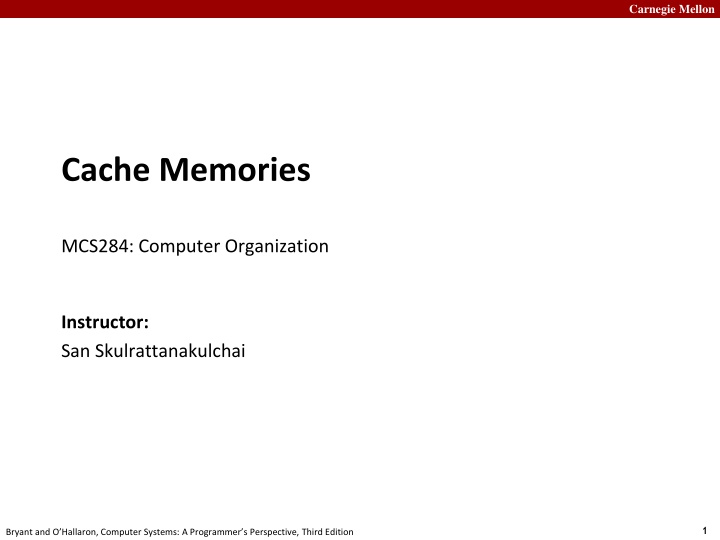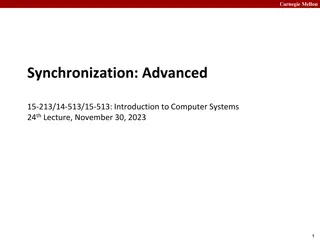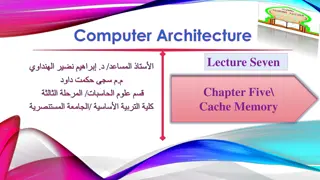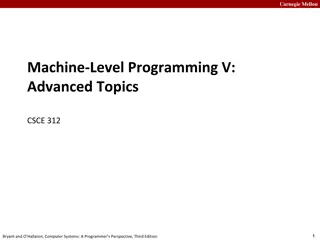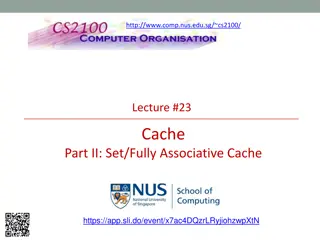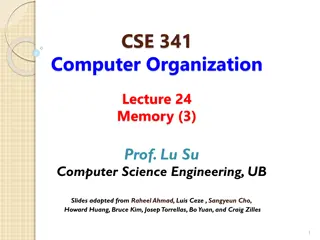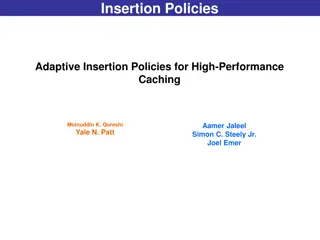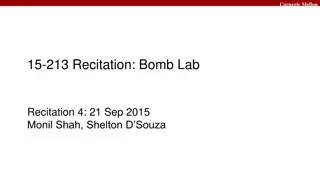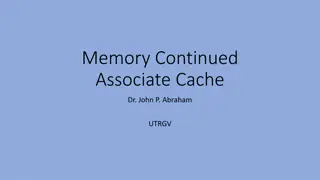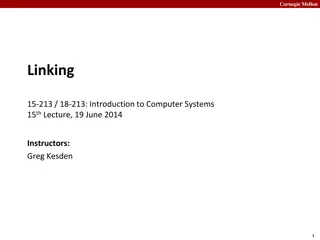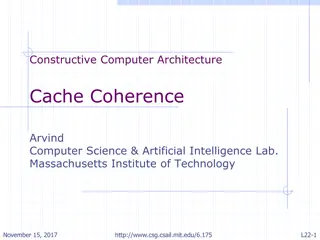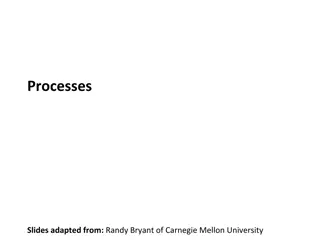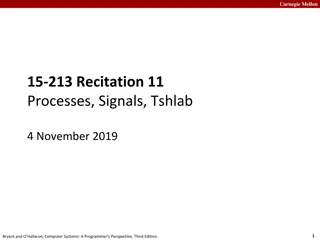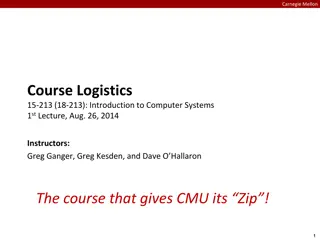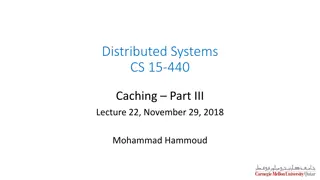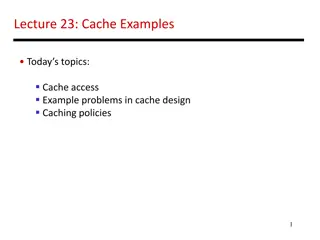Carnegie Mellon Cache Memories and Computer Organization
In this information from Carnegie Mellon, explore topics related to cache memory organization, performance impact of caches, memory hierarchy, cache concepts, and cache memory management in computer systems. Learn about the structure of cache memory, memory hierarchy levels, and general cache organization principles.
Download Presentation

Please find below an Image/Link to download the presentation.
The content on the website is provided AS IS for your information and personal use only. It may not be sold, licensed, or shared on other websites without obtaining consent from the author.If you encounter any issues during the download, it is possible that the publisher has removed the file from their server.
You are allowed to download the files provided on this website for personal or commercial use, subject to the condition that they are used lawfully. All files are the property of their respective owners.
The content on the website is provided AS IS for your information and personal use only. It may not be sold, licensed, or shared on other websites without obtaining consent from the author.
E N D
Presentation Transcript
Carnegie Mellon Cache Memories MCS284: Computer Organization Instructor: San Skulrattanakulchai 1 Bryant and O Hallaron, Computer Systems: A Programmer s Perspective, Third Edition
Carnegie Mellon Today Cache memory organization and operation Performance impact of caches The memory mountain Rearranging loops to improve spatial locality Using blocking to improve temporal locality 2 Bryant and O Hallaron, Computer Systems: A Programmer s Perspective, Third Edition
Carnegie Mellon Example Memory Hierarchy Smaller, faster, and costlier (per byte) storage devices L0: Regs CPU registers hold words retrieved from the L1 cache. L1 cache (SRAM) L1: L1 cache holds cache lines retrieved from the L2 cache. L2 cache (SRAM) L2: L2 cache holds cache lines retrieved from L3 cache L3 cache (SRAM) L3: L3 cache holds cache lines retrieved from main memory. Larger, slower, and cheaper (per byte) storage devices L4: Main memory (DRAM) Main memory holds disk blocks retrieved from local disks. Local secondary storage (local disks) L5: Local disks hold files retrieved from disks on remote servers Remote secondary storage (e.g., Web servers) L6: 3 Bryant and O Hallaron, Computer Systems: A Programmer s Perspective, Third Edition
Carnegie Mellon General Cache Concept Smaller, faster, more expensive memory caches a subset of the blocks Cache 8 4 9 14 10 3 Data is copied in block-sized transfer units 4 10 Larger, slower, cheaper memory viewed as partitioned into blocks Memory 0 1 2 3 4 4 5 6 7 8 9 10 10 11 12 13 14 15 4 Bryant and O Hallaron, Computer Systems: A Programmer s Perspective, Third Edition
Carnegie Mellon Cache Memories Cache memories are small, fast SRAM-based memories managed automatically in hardware Hold frequently accessed blocks of main memory CPU looks first for data in cache, then in main memory Typical system structure: CPU chip Register file Cache memory ALU System bus Memory bus Main memory I/O Bus interface bridge 5 Bryant and O Hallaron, Computer Systems: A Programmer s Perspective, Third Edition
Carnegie Mellon General Cache Organization (S, E, B) E = 2e lines per set set line S = 2s sets Cache size: C = S x E x B data bytes B-1 tag 0 1 2 v valid bit B = 2b bytes per cache block (the data) 6 Bryant and O Hallaron, Computer Systems: A Programmer s Perspective, Third Edition
Carnegie Mellon Locate set Check if any line in set has matching tag Yes + line valid: hit Locate data starting at offset Cache Read E = 2e lines per set Address of word: t bits s bits b bits S = 2s sets set index block offset tag data begins at this offset tag B-1 v 0 1 2 valid bit B = 2b bytes per cache block (the data) 7 Bryant and O Hallaron, Computer Systems: A Programmer s Perspective, Third Edition
Carnegie Mellon Example: Direct Mapped Cache (E = 1) Direct mapped: One line per set Assume: cache block size 8 bytes Address of int: v tag 0 1 2 3 4 5 6 7 t bits 0 01 100 v tag 0 1 2 3 4 5 6 7 find set S = 2s sets v tag 0 1 2 3 4 5 6 7 tag v 0 1 2 3 4 5 6 7 8 Bryant and O Hallaron, Computer Systems: A Programmer s Perspective, Third Edition
Carnegie Mellon Example: Direct Mapped Cache (E = 1) Direct mapped: One line per set Assume: cache block size 8 bytes Address of int: valid? + match: assume yes = hit t bits 0 01 100 v tag tag 0 1 2 3 4 5 6 7 block offset 9 Bryant and O Hallaron, Computer Systems: A Programmer s Perspective, Third Edition
Carnegie Mellon Example: Direct Mapped Cache (E = 1) Direct mapped: One line per set Assume: cache block size 8 bytes Address of int: valid? + match: assume yes = hit t bits 0 01 100 v tag 0 1 2 3 4 5 6 7 block offset int (4 Bytes) is here If tag doesn t match: old line is evicted and replaced 10 Bryant and O Hallaron, Computer Systems: A Programmer s Perspective, Third Edition
Carnegie Mellon Direct-Mapped Cache Simulation t=1 s=2 xx b=1 x M=16 bytes (4-bit addresses), B=2 bytes/block, S=4 sets, E=1 Blocks/set x Address trace (reads, one byte per read): 0 [00002], 1 [00012], 7 [01112], 8 [10002], 0 [00002] miss hit miss miss miss v Tag Block M[0-1] M[8-9] M[0-1] 0 1 1 1 ? 0 1 0 ? Set 0 Set 1 Set 2 Set 3 1 0 M[6-7] 11 Bryant and O Hallaron, Computer Systems: A Programmer s Perspective, Third Edition
Carnegie Mellon E-way Set Associative Cache (Here: E = 2) E = 2: Two lines per set Assume: cache block size 8 bytes Address of short int: t bits 0 01 100 v tag 0 1 2 3 4 5 6 7 v tag 0 1 2 3 4 5 6 7 find set v tag 0 1 2 3 4 5 6 7 v tag 0 1 2 3 4 5 6 7 v tag 0 1 2 3 4 5 6 7 v tag 0 1 2 3 4 5 6 7 v tag 0 1 2 3 4 5 6 7 v tag 0 1 2 3 4 5 6 7 12 Bryant and O Hallaron, Computer Systems: A Programmer s Perspective, Third Edition
Carnegie Mellon E-way Set Associative Cache (Here: E = 2) E = 2: Two lines per set Assume: cache block size 8 bytes Address of short int: t bits 0 01 100 compare both valid? + match: yes = hit v tag tag 0 1 2 3 4 5 6 7 v tag 0 1 2 3 4 5 6 7 block offset 13 Bryant and O Hallaron, Computer Systems: A Programmer s Perspective, Third Edition
Carnegie Mellon E-way Set Associative Cache (Here: E = 2) E = 2: Two lines per set Assume: cache block size 8 bytes Address of short int: t bits 0 01 100 compare both valid? + match: yes = hit v tag 0 1 2 3 4 5 6 7 v tag 0 1 2 3 4 5 6 7 block offset short int (2 Bytes) is here No match: One line in set is selected for eviction and replacement Replacement policies: random, least recently used (LRU), 14 Bryant and O Hallaron, Computer Systems: A Programmer s Perspective, Third Edition
Carnegie Mellon 2-Way Set Associative Cache Simulation t=2 s=1 x b=1 x M=16 byte addresses, B=2 bytes/block, S=2 sets, E=2 blocks/set xx Address trace (reads, one byte per read): 0 [00002], 1 [00012], 7 [01112], 8 [10002], 0 [00002] miss hit miss miss hit v Tag Block 0 0 1 ? 00 10 ? M[0-1] M[8-9] 1 Set 0 0 0 1 01 M[6-7] Set 1 15 Bryant and O Hallaron, Computer Systems: A Programmer s Perspective, Third Edition
Carnegie Mellon What about writes? Multiple copies of data exist: L1, L2, L3, Main Memory, Disk What to do on a write-hit? Write-through (write immediately to memory) Write-back (defer write to memory until replacement of line) Need a dirty bit (line different from memory or not) What to do on a write-miss? Write-allocate (load into cache, update line in cache) Good if more writes to the location follow No-write-allocate (writes straight to memory, does not load into cache) Typical Write-through + No-write-allocate Write-back + Write-allocate 16 Bryant and O Hallaron, Computer Systems: A Programmer s Perspective, Third Edition
Carnegie Mellon Intel Core i7 Cache Hierarchy Processor package Core 0 Core 3 L1 i-cache and d-cache: 32 KB, 8-way, Access: 4 cycles Regs Regs L1 L1 L1 L1 L2 unified cache: 256 KB, 8-way, Access: 10 cycles d-cache i-cache d-cache i-cache L2 unified cache L2 unified cache L3 unified cache: 8 MB, 16-way, Access: 40-75 cycles L3 unified cache (shared by all cores) Block size: 64 bytes for all caches. Main memory 17 Bryant and O Hallaron, Computer Systems: A Programmer s Perspective, Third Edition
Carnegie Mellon Cache Performance Metrics Miss Rate Fraction of memory references not found in cache (misses / accesses) = 1 hit rate Typical numbers (in percentages): 3-10% for L1 can be quite small (e.g., < 1%) for L2, depending on size, etc. Hit Time Time to deliver a line in the cache to the processor includes time to determine whether the line is in the cache Typical numbers: 4 clock cycle for L1 10 clock cycles for L2 Miss Penalty Additional time required because of a miss typically 50-200 cycles for main memory (Trend: increasing!) 18 Bryant and O Hallaron, Computer Systems: A Programmer s Perspective, Third Edition
Carnegie Mellon Let s think about those numbers Huge difference between a hit and a miss Could be 100x, if just L1 and main memory Would you believe 99% hits is twice as good as 97%? Consider: cache hit time of 1 cycle miss penalty of 100 cycles Average access time: 97% hits: 1 cycle + 0.03 * 100 cycles = 4 cycles 99% hits: 1 cycle + 0.01 * 100 cycles = 2 cycles This is why miss rate is used instead of hit rate 19 Bryant and O Hallaron, Computer Systems: A Programmer s Perspective, Third Edition
Carnegie Mellon Writing Cache Friendly Code Make the common case go fast Focus on the inner loops of the core functions Minimize the misses in the inner loops Repeated references to variables are good (temporal locality) Stride-1 reference patterns are good (spatial locality) Key idea: Our qualitative notion of locality is quantified through our understanding of cache memories 20 Bryant and O Hallaron, Computer Systems: A Programmer s Perspective, Third Edition
Carnegie Mellon Today Cache organization and operation Performance impact of caches The memory mountain Rearranging loops to improve spatial locality Using blocking to improve temporal locality 21 Bryant and O Hallaron, Computer Systems: A Programmer s Perspective, Third Edition
Carnegie Mellon The Memory Mountain Read throughput (read bandwidth) Number of bytes read from memory per second (MB/s) Memory mountain: Measured read throughput as a function of spatial and temporal locality. Compact way to characterize memory system performance. 22 Bryant and O Hallaron, Computer Systems: A Programmer s Perspective, Third Edition
Carnegie Mellon Memory Mountain Test Function long data[MAXELEMS]; /* Global array to traverse */ /* test - Iterate over first "elems" elements of * array data with stride of "stride", using * using 4x4 loop unrolling. */ int test(int elems, int stride) { long i, sx2=stride*2, sx3=stride*3, sx4=stride*4; long acc0 = 0, acc1 = 0, acc2 = 0, acc3 = 0; long length = elems, limit = length - sx4; Call test() with many combinations of elems and stride. For each elems and stride: 1. Call test() once to warm up the caches. /* Combine 4 elements at a time */ for (i = 0; i < limit; i += sx4) { acc0 = acc0 + data[i]; acc1 = acc1 + data[i+stride]; acc2 = acc2 + data[i+sx2]; acc3 = acc3 + data[i+sx3]; } 2. Call test() again and measure the read throughput(MB/s) /* Finish any remaining elements */ for (; i < length; i++) { acc0 = acc0 + data[i]; } return ((acc0 + acc1) + (acc2 + acc3)); } mountain/mountain.c 23 Bryant and O Hallaron, Computer Systems: A Programmer s Perspective, Third Edition
Carnegie Mellon Core i7 Haswell 2.1 GHz 32 KB L1 d-cache 256 KB L2 cache 8 MB L3 cache 64 B block size The Memory Mountain Aggressive prefetching 16000 L1 14000 Read throughput (MB/s) 12000 10000 Ridges of temporal locality 8000 L2 6000 4000 L3 2000 Slopes of spatial locality 0 32k s1 128k s3 Mem 512k s5 2m s7 8m Stride (x8 bytes) s9 Size (bytes) 32m s11 128m 24 Bryant and O Hallaron, Computer Systems: A Programmer s Perspective, Third Edition
Carnegie Mellon Today Cache organization and operation Performance impact of caches The memory mountain Rearranging loops to improve spatial locality Using blocking to improve temporal locality 25 Bryant and O Hallaron, Computer Systems: A Programmer s Perspective, Third Edition
Carnegie Mellon Matrix Multiplication Example Variable sum held in register Description: Multiply N x N matrices Matrix elements are doubles (8 bytes) O(N3) total operations N reads per source element N values summed per destination /* ijk */ for (i=0; i<n; i++) { for (j=0; j<n; j++) { sum = 0.0; for (k=0; k<n; k++) sum += a[i][k] * b[k][j]; c[i][j] = sum; } } matmult/mm.c but may be able to hold in register 26 Bryant and O Hallaron, Computer Systems: A Programmer s Perspective, Third Edition
Carnegie Mellon Miss Rate Analysis for Matrix Multiply Assume: Block size = 32B (big enough for four doubles) Matrix dimension (N) is very large Approximate 1/N as 0.0 Cache is not even big enough to hold multiple rows Analysis Method: Look at access pattern of inner loop j j k = x i i k C A B 27 Bryant and O Hallaron, Computer Systems: A Programmer s Perspective, Third Edition
Carnegie Mellon Layout of C Arrays in Memory (review) C arrays allocated in row-major order each row in contiguous memory locations Stepping through columns in one row: for (i = 0; i < N; i++) sum += a[0][i]; accesses successive elements if block size (B) > sizeof(aij) bytes, exploit spatial locality miss rate = sizeof(aij) / B Stepping through rows in one column: for (i = 0; i < n; i++) sum += a[i][0]; accesses distant elements no spatial locality! miss rate = 1 (i.e. 100%) 28 Bryant and O Hallaron, Computer Systems: A Programmer s Perspective, Third Edition
Carnegie Mellon Matrix Multiplication (ijk) /* ijk */ for (i=0; i<n; i++) { for (j=0; j<n; j++) { sum = 0.0; for (k=0; k<n; k++) sum += a[i][k] * b[k][j]; c[i][j] = sum; } } Inner loop: (*,j) (i,j) (i,*) A B C matmult/mm.c Row-wise Column- wise Fixed Misses per inner loop iteration: A 0.25 B 1.0 C 0.0 29 Bryant and O Hallaron, Computer Systems: A Programmer s Perspective, Third Edition
Carnegie Mellon Matrix Multiplication (jik) /* jik */ for (j=0; j<n; j++) { for (i=0; i<n; i++) { sum = 0.0; for (k=0; k<n; k++) sum += a[i][k] * b[k][j]; c[i][j] = sum } } Inner loop: (*,j) (i,j) (i,*) A B C matmult/mm.c Row-wise Column- Fixed wise Misses per inner loop iteration: A 0.25 B 1.0 C 0.0 30 Bryant and O Hallaron, Computer Systems: A Programmer s Perspective, Third Edition
Carnegie Mellon Matrix Multiplication (kij) /* kij */ for (k=0; k<n; k++) { for (i=0; i<n; i++) { r = a[i][k]; for (j=0; j<n; j++) c[i][j] += r * b[k][j]; } } Inner loop: (i,k) (k,*) (i,*) A B C Row-wise Row-wise Fixed matmult/mm.c Misses per inner loop iteration: A 0.0 B C 0.25 0.25 31 Bryant and O Hallaron, Computer Systems: A Programmer s Perspective, Third Edition
Carnegie Mellon Matrix Multiplication (ikj) /* ikj */ for (i=0; i<n; i++) { for (k=0; k<n; k++) { r = a[i][k]; for (j=0; j<n; j++) c[i][j] += r * b[k][j]; } } Inner loop: (i,k) (k,*) (i,*) A B C matmult/mm.c Row-wise Row-wise Fixed Misses per inner loop iteration: A 0.0 B C 0.25 0.25 32 Bryant and O Hallaron, Computer Systems: A Programmer s Perspective, Third Edition
Carnegie Mellon Matrix Multiplication (jki) Inner loop: /* jki */ for (j=0; j<n; j++) { for (k=0; k<n; k++) { r = b[k][j]; for (i=0; i<n; i++) c[i][j] += a[i][k] * r; } } (*,k) (*,j) (k,j) A B C Column- wise Fixed Column- wise matmult/mm.c Misses per inner loop iteration: A 1.0 B 0.0 C 1.0 33 Bryant and O Hallaron, Computer Systems: A Programmer s Perspective, Third Edition
Carnegie Mellon Matrix Multiplication (kji) /* kji */ for (k=0; k<n; k++) { for (j=0; j<n; j++) { r = b[k][j]; for (i=0; i<n; i++) c[i][j] += a[i][k] * r; } } Inner loop: (*,k) (*,j) (k,j) A B C matmult/mm.c Column- wise Fixed Column- wise Misses per inner loop iteration: A 1.0 B 0.0 C 1.0 34 Bryant and O Hallaron, Computer Systems: A Programmer s Perspective, Third Edition
Carnegie Mellon Summary of Matrix Multiplication for (i=0; i<n; i++) { for (j=0; j<n; j++) { sum = 0.0; for (k=0; k<n; k++) sum += a[i][k] * b[k][j]; c[i][j] = sum; } } ijk (& jik): 2 loads, 0 stores misses/iter = 1.25 for (k=0; k<n; k++) { for (i=0; i<n; i++) { r = a[i][k]; for (j=0; j<n; j++) c[i][j] += r * b[k][j]; } } kij (& ikj): 2 loads, 1 store misses/iter = 0.5 for (j=0; j<n; j++) { for (k=0; k<n; k++) { r = b[k][j]; for (i=0; i<n; i++) c[i][j] += a[i][k] * r; } jki (& kji): 2 loads, 1 store misses/iter = 2.0 Bryant and O Hallaron, Computer Systems: A Programmer s Perspective, Third Edition } 35
Carnegie Mellon Core i7 Matrix Multiply Performance 100 jki / kji Cycles per inner loop iteration ijk / jik jki kji ijk jik kij ikj 10 kij / ikj 1 50 100 150 200 250 300 350 Array size (n) 400 450 500 550 600 650 700 36 Bryant and O Hallaron, Computer Systems: A Programmer s Perspective, Third Edition
Carnegie Mellon Today Cache organization and operation Performance impact of caches The memory mountain Rearranging loops to improve spatial locality Using blocking to improve temporal locality 37 Bryant and O Hallaron, Computer Systems: A Programmer s Perspective, Third Edition
Carnegie Mellon Example: Matrix Multiplication c = (double *) calloc(sizeof(double), n*n); /* Multiply n x n matrices a and b */ void mmm(double *a, double *b, double *c, int n) { int i, j, k; for (i = 0; i < n; i++) for (j = 0; j < n; j++) for (k = 0; k < n; k++) c[i*n + j] += a[i*n + k] * b[k*n + j]; } j c a b = * i 38 Bryant and O Hallaron, Computer Systems: A Programmer s Perspective, Third Edition
Carnegie Mellon Cache Miss Analysis Assume: Matrix elements are doubles Cache block = 8 doubles Cache size C << n (much smaller than n) n First iteration: n/8 + n = 9n/8 misses = * Afterwards in cache: (schematic) = * 8 wide 39 Bryant and O Hallaron, Computer Systems: A Programmer s Perspective, Third Edition
Carnegie Mellon Cache Miss Analysis Assume: Matrix elements are doubles Cache block = 8 doubles Cache size C << n (much smaller than n) n Second iteration: Again: n/8 + n = 9n/8 misses = * 8 wide Total misses: 9n/8 * n2 = (9/8) * n3 40 Bryant and O Hallaron, Computer Systems: A Programmer s Perspective, Third Edition
Carnegie Mellon Blocked Matrix Multiplication c = (double *) calloc(sizeof(double), n*n); /* Multiply n x n matrices a and b */ void mmm(double *a, double *b, double *c, int n) { int i, j, k; for (i = 0; i < n; i+=B) for (j = 0; j < n; j+=B) for (k = 0; k < n; k+=B) /* B x B mini matrix multiplications */ for (i1 = i; i1 < i+B; i++) for (j1 = j; j1 < j+B; j++) for (k1 = k; k1 < k+B; k++) } c[i1*n+j1] += a[i1*n + k1]*b[k1*n + j1]; matmult/bmm.c j1 c a b c = + * i1 Block size B x B 41 Bryant and O Hallaron, Computer Systems: A Programmer s Perspective, Third Edition
Carnegie Mellon Cache Miss Analysis Assume: Cache block = 8 doubles Cache size C << n (much smaller than n) Three blocks fit into cache: 3B2 < C n/B blocks First (block) iteration: B2/8 misses for each block 2n/B * B2/8 = nB/4 (omitting matrix c) = * Block size B x B Afterwards in cache (schematic) = * 42 Bryant and O Hallaron, Computer Systems: A Programmer s Perspective, Third Edition
Carnegie Mellon Cache Miss Analysis Assume: Cache block = 8 doubles Cache size C << n (much smaller than n) Three blocks fit into cache: 3B2 < C n/B blocks Second (block) iteration: Same as first iteration 2n/B * B2/8 = nB/4 = * Total misses: nB/4 * (n/B)2 = n3/(4B) Block size B x B 43 Bryant and O Hallaron, Computer Systems: A Programmer s Perspective, Third Edition
Carnegie Mellon Blocking Summary No blocking: (9/8) * n3 Blocking: 1/(4B) * n3 Suggest largest possible block size B, but limit 3B2 < C! Reason for dramatic difference: Matrix multiplication has inherent temporal locality: Input data: 3n2, computation 2n3 Every array elements used O(n) times! But program has to be written properly 44 Bryant and O Hallaron, Computer Systems: A Programmer s Perspective, Third Edition
Carnegie Mellon Cache Summary Cache memories can have significant performance impact You can write your programs to exploit this! Focus on the inner loops, where bulk of computations and memory accesses occur. Try to maximize spatial locality by reading data objects with sequentially with stride 1. Try to maximize temporal locality by using a data object as often as possible once it s read from memory. 45 Bryant and O Hallaron, Computer Systems: A Programmer s Perspective, Third Edition
